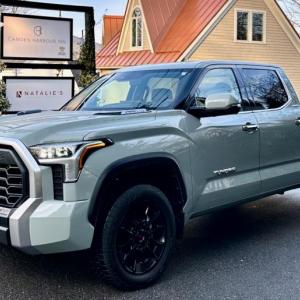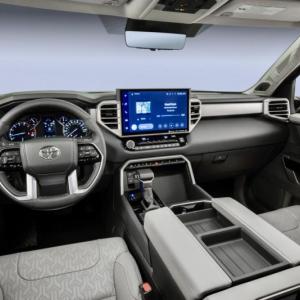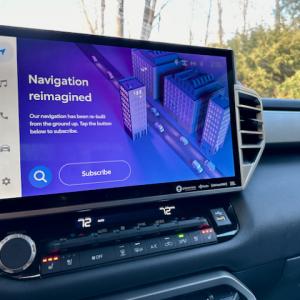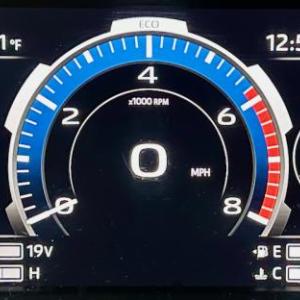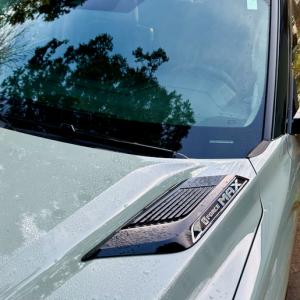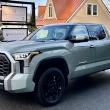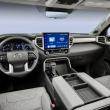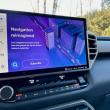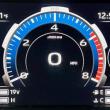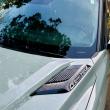Toyota Tundra HV 4X4 Limited Crewmax 5.5
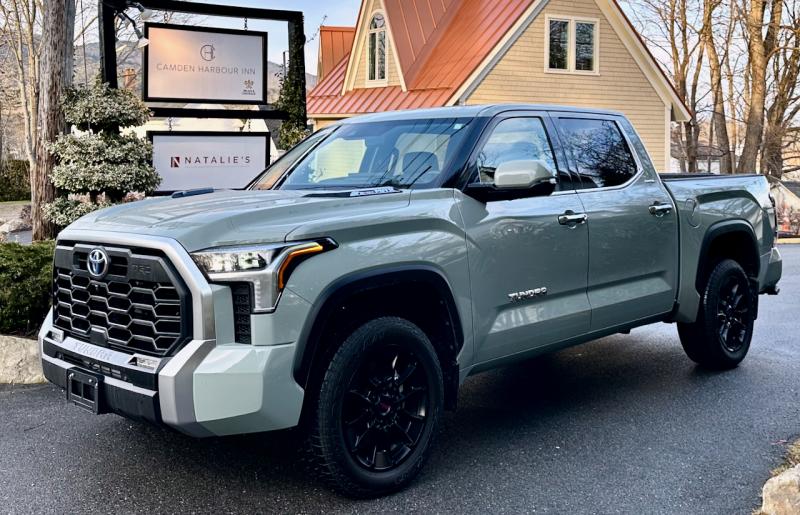 A four-door Crewmax version of the Tundra, with a 65-inch bed. (That’s 5.5 feet for you truckers.) Note the cosmetics and stance of the TRD Off-Road Package. This color is Lunar Rock.
A four-door Crewmax version of the Tundra, with a 65-inch bed. (That’s 5.5 feet for you truckers.) Note the cosmetics and stance of the TRD Off-Road Package. This color is Lunar Rock.
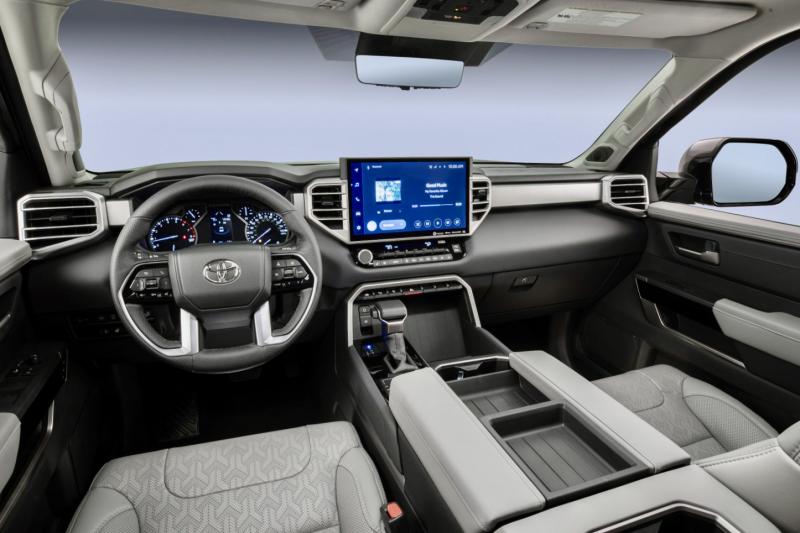 The Tundra, which received a makeover for 2022, has a comfortable and functional cabin, with (in top trim) many of the features, if not the materials and esthetics, of luxury vehicles; it’s a truck. Leather is available.
The Tundra, which received a makeover for 2022, has a comfortable and functional cabin, with (in top trim) many of the features, if not the materials and esthetics, of luxury vehicles; it’s a truck. Leather is available.
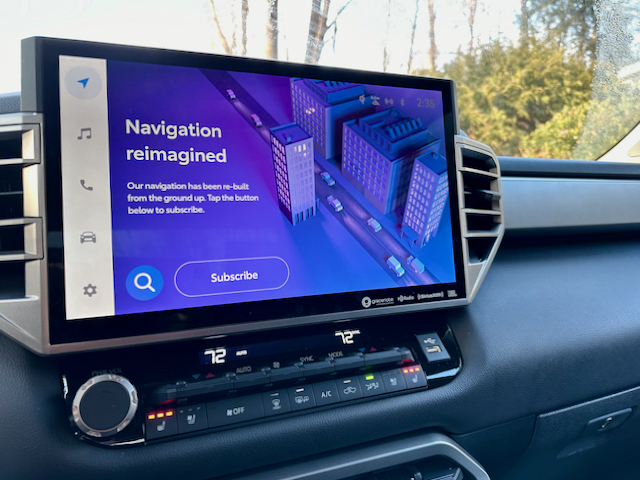 The large (14-inch) multimedia touchscreen on upper trim levels of the Tundra. That’s an on-off/volume switch for the stereo, but tuning the radio requires tapping into a computer menu.
The large (14-inch) multimedia touchscreen on upper trim levels of the Tundra. That’s an on-off/volume switch for the stereo, but tuning the radio requires tapping into a computer menu.
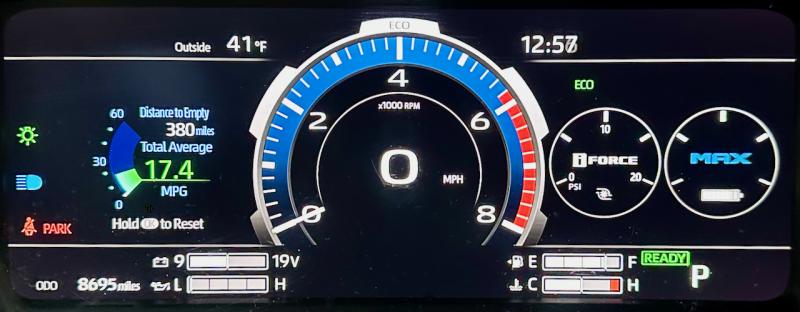 The Tundra driver’s screen. A windshield head-up display is an available option.
The Tundra driver’s screen. A windshield head-up display is an available option.
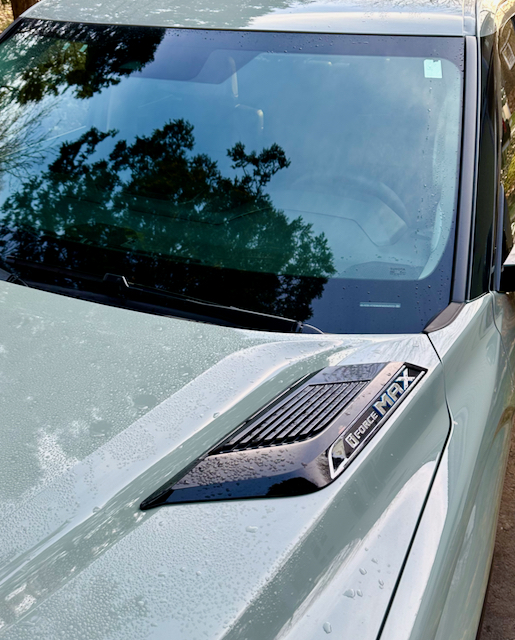 These are not snorkels that feed air to the engine while the truck is fording a stream; in fact, they don’t do anything at all except sit there and look purposeful.
These are not snorkels that feed air to the engine while the truck is fording a stream; in fact, they don’t do anything at all except sit there and look purposeful.
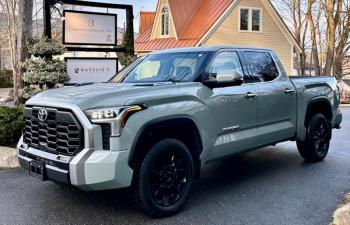 A four-door Crewmax version of the Tundra, with a 65-inch bed. (That’s 5.5 feet for you truckers.) Note the cosmetics and stance of the TRD Off-Road Package. This color is Lunar Rock.
A four-door Crewmax version of the Tundra, with a 65-inch bed. (That’s 5.5 feet for you truckers.) Note the cosmetics and stance of the TRD Off-Road Package. This color is Lunar Rock.
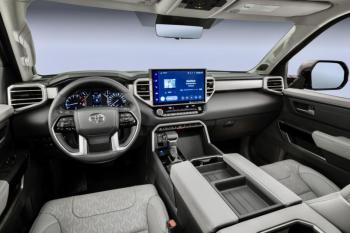 The Tundra, which received a makeover for 2022, has a comfortable and functional cabin, with (in top trim) many of the features, if not the materials and esthetics, of luxury vehicles; it’s a truck. Leather is available.
The Tundra, which received a makeover for 2022, has a comfortable and functional cabin, with (in top trim) many of the features, if not the materials and esthetics, of luxury vehicles; it’s a truck. Leather is available.
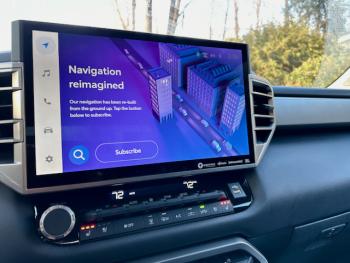 The large (14-inch) multimedia touchscreen on upper trim levels of the Tundra. That’s an on-off/volume switch for the stereo, but tuning the radio requires tapping into a computer menu.
The large (14-inch) multimedia touchscreen on upper trim levels of the Tundra. That’s an on-off/volume switch for the stereo, but tuning the radio requires tapping into a computer menu.
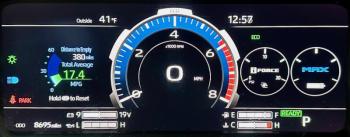 The Tundra driver’s screen. A windshield head-up display is an available option.
The Tundra driver’s screen. A windshield head-up display is an available option.
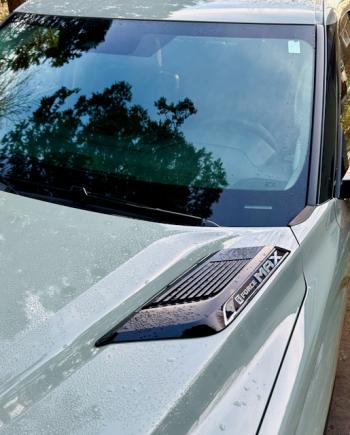 These are not snorkels that feed air to the engine while the truck is fording a stream; in fact, they don’t do anything at all except sit there and look purposeful.
These are not snorkels that feed air to the engine while the truck is fording a stream; in fact, they don’t do anything at all except sit there and look purposeful.
There are two niggles on the recently updated Tundra, Toyota’s large pickup truck. One is the message that appears on the big touchscreen when the engine starts: Navigation reimagined . . . Tap the button below to subscribe. Really, Toyota? We have to pay extra for a satellite navigation app now? What’s next—swiping a credit card when we want heat or A/C?
The other disappointment is the pair of air inlets atop the hood, one on each side near the base of the windshield. I took these to be snorkels, part of our truck’s off-road equipment. Such top-mounted air inlets let the engine breathe even when the vehicle is up to its door handles in water; but on the Tundra they’re just for looks.
Now, to be fair, wireless Apple CarPlay and Android Auto come standard as part of Toyota’s Multimedia system, so satnav is available without a subscription—if someone on board has a smartphone. (Pretty safe bet these days.) And the rest of the off-road equipment is more than adequate, so if the Tundra can’t wade quite so deep . . . maybe that’s when we launch the boat we’ve been hauling on the trailer behind. After all, our Tundra also has the Towing Technology Package with a 12,000-pound capacity.
Although that’ll haul a sizeable boat, it’s much less than the maximum towing capacity of the gnarliest, most heavy-duty domestic pickup trucks. But the Tundra—which, BTW, is made in Texas—is superior as an all-around, nearly-everyday sort of vehicle. It’s a full-size half-ton pickup that I can thread into my driveway without making a two-point turn. I don’t need a Coast Guard 100-ton license to pilot it, either.
Having done away with the V-8 option, Toyota now offers a choice of 3.5-litre V-6 engines in the Tundra, tuned to 348 or 389 horsepower, or the i-FORCE Max light-hybrid powerplant in our sample HV (High Voltage) truck. With an additional 48 horses and 148 torques from its in-line electric motor-generator, it makes a combined 437 horsepower and 583 pound-feet of torque on tap. It rumbles like a V-8, too.
(The hybrid’s 288-volt battery is tucked under the back seat; the HV option is available only in the stretched Crewmax body style.)
With the well-programmed 10-speed automatic transmission, there’s plenty of acceleration available. At very slow speeds, it’s possible to drive on electricity alone, at least briefly, but the HV’s MPG remains unimpressive—in the mid to upper teens around town. The real value of the hybrid drive is the extra smoothness and torque it provides.
For a traditional, body-on-frame vehicle, the Tundra is a comfortable highway cruiser; the shell is free of creaks and unexpected movements and the relatively tranquil ride is aided & abetted by coil-spring suspension at the rear wheels. In the steering and stopping departments, if the Tundra doesn’t behave like a sedan, much less a sports car, neither does it wander numbly.
Our Tundra’s on-road handling might be even better without its TRD Off-Road package, a $3,050 option that includes (along with plenty of distinguishing cosmetics) 20-inch wheels with knobby tires, long-travel Bilstein shock absorbers, an electronic locking rear differential, five terrain modes and skid plates. Along with hill-descent control, there’s also Crawl Control, which automatically adjusts the throttle and brakes for best traction in low-range, off-road driving.
The Tundra Limited comes standard with toys galore, including keyless ignition, automatic two-zone climate control, dynamic cruise control, blind-spot monitors, a wireless phone charger and Toyota’s comprehensive Safety Sense 2.5 suite of safety apps.
Domestic-brand pickups now compete on the basis of who’s got the trickest tailgate, but the Tundra offers only a keyfob-actuated “soft” tailgate release—no built-in steps, rails, handholds or tie-downs; just a $794 swing-out bed extender that turns the tailgate into a load-bearing surface.
When Toyota announced, 33 years ago, that it would enter the full-size-pickup market, I had to smile, imagining the reaction of Toyota engineers when they were presented with an American pickup of the time and told to get cracking and make one of these stone axes: What? Seriously? Toyota’s small trucks already had a reputation as unkillable workhorses, but owners who wanted something bigger were going to GM and Ford. The 1992 T100 that followed was a half-hearted attempt at best, but Toyota was off to the truck races.
Yet today’s Tundra, new & improved as it is—and with a choice of seven trims, two cab styles, two rear suspensions, three bed lengths and a multitude of options including a three-inch lift kit—still lags behind its Ford, Ram and GM counterparts in pickup-centric bragging rights: It no longer comes with a V-8, its towing and payload capacities are less, it’s somewhat smaller overall, and none of its interiors look like a Las Vegas hotel lobby.
On the other hand, pricey as Tundras have become—from a base level of $41,815, our loaded Limited climbed to $67,442 and a 1794 edition can hit $75,000—they still cost a good deal less than some of the Detroit iron; and don’t forget Toyota’s reputation for build quality and longevity. In the long run, the Tundra might just be the pickup value king.

